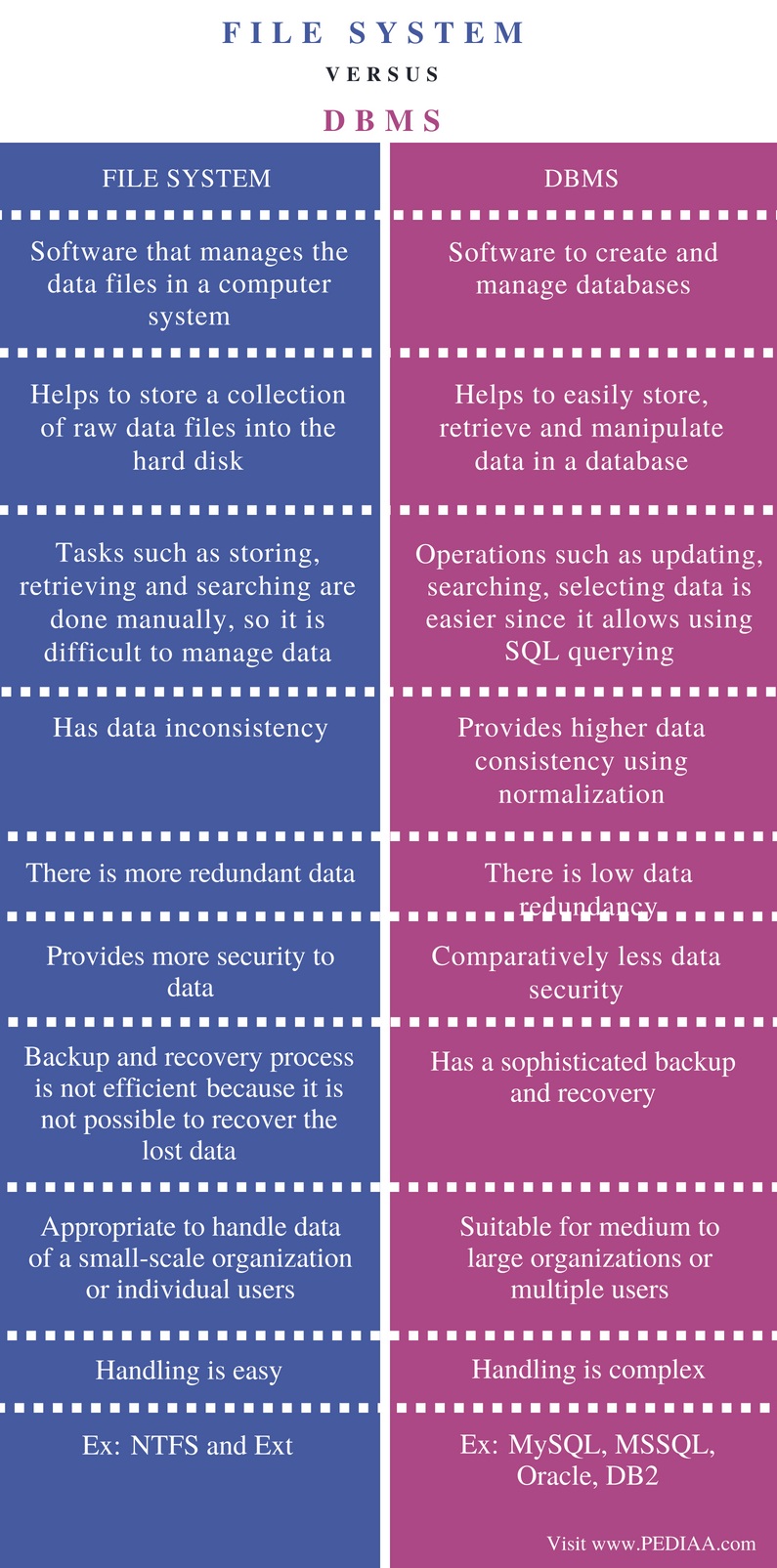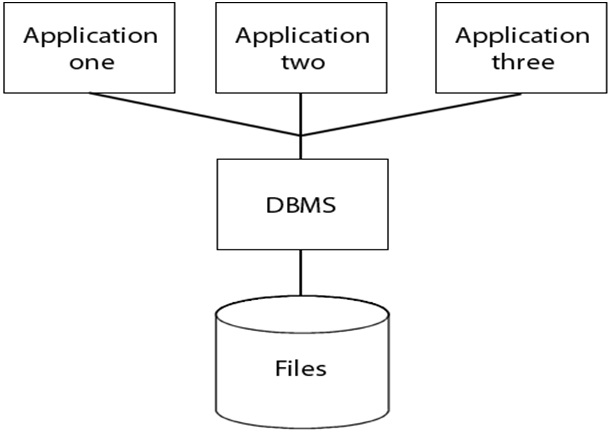Table of Contents
PC running slow?
In this guide, we’re going to identify some of the possible causes that might lead to using a traditional file system versus the database approach, and then point out possible solutions to this problem. Typically, there are a number of features that differ from conventional file management systems. In file system practice, each user defines and implements recommended files for managing a particular application. The database approach maintains a single data store that is specified once and then accessed by different users.
What Is A File System?
What is the difference between traditional file system and database system?
The difference between a file system and a DBMS is that the file system allows you to store a collection ofa collection of raw data file types, while the DBMS makes it easy to save, retrieve and process history in the database. In short, a DBMS offers more flexibility in accessing and managing parts than a file system.
A file system is a process in which files in a storage area such as media, hard drive, pen movement, DVD, etc. are composed of various file types such as mp3, mp4, txt, doc, etc. etc., organized into directories.

The file system allows you to control how data is searched for and written to media. It installs directly on desktop PCs with operating systems such as Windows and Linux.
What Is A DBMS?
PC running slow?
ASR Pro is the ultimate solution for your PC repair needs! Not only does it swiftly and safely diagnose and repair various Windows issues, but it also increases system performance, optimizes memory, improves security and fine tunes your PC for maximum reliability. So why wait? Get started today!

A database management system (DBMS) is software for storing and retrieving user data with appropriate security settings. It consists of a group of programs that are used to manage the database. The DBMS accepts a request for product data and asks the DBMS engine to offer you specific data. In large systems Mach DBMS helps users and other third-party software store and retrieve data.
Characteristics Of The Real Filesystem
- This helps to save data files to a filegroup.
- The checked files are linked.
- Different languages C / C ++ and COBOL were used to create the files.
- Support for shared file systems
- Fast file system recovery.
DBMS Functions
- Data directory available to users.
- Transaction
- Simultaneous assistance with recovery services
- Authorization services
- Data equality is the same in virtual locations.
- provides support for data transfer.
- Independent Application Services
- Allows multiple users to share a data file at the same time.
Difference Between File System And. DBMS
| filesystem | DBMS |
|---|---|
| System File is another program that manages and organizes the data records on the media. It controls information about how data is storedand are available. | A DBMS or database management system is application software. It is used to access, create and manage databases. |
| This file provides the system with detailed information on how to display and store data. | DBMS 1 provides an abstract data view hiding details |
| The storage and retrieval of records cannot be efficiently performed in the bank statement system. | The DBMS is efficient to use because there are many methods for storing and retrieving data. |
| No data on recovery processes is provided. | There is a backup copy for restoring data in the DBMS. |
| There is no disaster recovery mechanism in the file mechanism. | The DBMS provides a useful disaster recovery mechanism |
| Protecting the file system would be very difficult. | The DBMS offers a good security mechanism. |
| In a large file management system, redundancy data is more important. | Redundancy is reduced in the DBMSthem. |
| Data inconsistency enlarges the file system. | Data inconsistency is cheap in a database management system. |
| The file circle is less secure. | The database management system ensures high confidentiality. |
| file system allows all data to be saved as separate data files or objects. | The database management system also stores data because correlations and constraints are set. |
| Don’t store complex transactions. | Complex transactions that are easy to implement. |
| The concept of centralization is contained in a tight file management system. | Centralization is easy to achieve in a DBMS system. |
| Does not provide backup data recovery in case of data loss. | The DBMS provides device backup and data recovery even in case of loss. |
| There is no effective solution to problems in the file system. | You can easily query data in a SQL database. |
| This system does notAllows concurrency. | The DBMS hardware provides parallelism. |
Benefits Of The File System
- Apply standards development and maintenance.
- Helps reduce duplication
- Avoid file maintenance inconsistencies to achieve file independence.
- A solid theoretical base (for the model) is relational.
- In some situations, this is undoubtedly more efficient and cheaper than a great DBMS.
- The design of the startup process is simpler than the design of the database.
Benefits Associated With The DBMS System
- The DBMS offers many methods for storing and retrieving data.
- Unified data processing capabilities.
- Application programmers have never encountered problems with data presentation and storage.
- The DBMS uses several powerful functions to store and save data efficiently.
- Ensures data integrity and security.
- The DBMS includes integrity constraints to provide a higher level of protection against data access.
- Time shortening application development.
- Use less storage space
- Reduce redundancy.
- Data independence.
Filesystem Application
- Runtime libraries for different languages.
- API programs that use it to send requests to the file system.
- It is used for data transmission and location determination. You
- help write for metadata
- Manage directories.
Using The System DBMS
- Library system for the entrance examination system
- Payroll and personnel calculation system.
- Booking system Hotel booking system Air tickets booking system
- It is used in the banking system for customer information, account transactions, payments, deposits, loans, etc.
- Will be used by airlines for bookings and flight schedules.
- DBMS is also used in universities to keep records of calls, monthly service bills, balances, etc.
- Financial memory for getting informationInformation about stocks, sales and purchases of financial products such as stocks and bonds.
Disadvantages Of The File System
- Each application has its own data file, which may require publishing and saving the same data multiple times.
- The data dependency for each file processing depends on the system data, but the specific issue is incompatible with the file format.
- Limited distribution of datasets.
- Security issue.
- It takes time.
- Allows you to manage archives of a large agency with a large number of articles.
- Often work themes need some work.
Disadvantages Of The DBMS
- The cost of DBMS hardware and software is quite high, which increases your business budget.
- Most database support systems are often complex systems, so complete user training is required to work with the DBMS.
- The simultaneous use of the same drug by many users results in the loss of some data.
- DBMS can’t youperform complex calculations
- Datasets get larger because they provide higher expected response times for queries. Required
- is a high speed data processor.
- Writing may fail due to power failure or failure, or the entire system may be shut down.
- DBMS costs vary by environment, features, or annual recurring maintenance costs.
Main Differences:
- A file product is software that manages and organizes files on a medium, and a DBMS is a software application used to access, create and maintain databases.
- There is no disaster recovery mechanism in the file system, other DBMS provide you with a disaster recovery mechanism.
- Data inconsistency is at the top of the system file. When using different data, the inconsistency in the database management system is low.
- The file system does not provide transfer of transactions, it is complex, while in the DBMS system it is easy to implement the transferOperations using SQL.
- The file system does not offer concurrency, but the DBMS does offer concurrency.

Improve the speed of your computer today by downloading this software - it will fix your PC problems.
What are the differences between file and database approach?
The file format is defined in the application manual, so programs are written to perform special functions / applications. Database approach Collect pragmatically related data together, some of which can be published for an application.
What is traditional file system and database?
Traditional file system (TFS) is a way of storing and organizing computer files and therefore information in a file (data). Essentially, it organizes these files into repositories for storage, organization, editing, and retrieval by the computer’s operating system.
Tipps Zur Wiederherstellung Eines Traditionellen Dateisystems Im Vergleich Zu Einem Datenbankansatz
Tips Voor Het Herstellen Van Een Traditioneel Bestandssysteem Versus Een Database-aanpak
Suggerimenti Per Il Ripristino Di Qualsiasi Tipo Di File System Tradizionale Rispetto A Un Approccio Al Database
Conseils Pour Récupérer Un Système De Fichiers Traditionnel Par Rapport à Une Approche De Base De Données
기존 파일 시스템과 데이터베이스 접근 방식을 복구하기 위한 팁
Tips För Att återställa Ett Traditionellt Filsystem Mot En Databasmetod
Советы по восстановлению традиционной файловой системы по сравнению с подходом к базе данных
Consejos Para Recuperar Un Sistema De Archivos Tradicional Frente A Un Enfoque De Base De Datos
Wskazówki Dotyczące Odzyskiwania Tradycyjnego Systemu Plików W Porównaniu Z Podejściem Do Bazy Danych
Dicas Para Recuperar Um Sistema De Arquivos Tradicional Versus Uma Abordagem De Banco De Dados